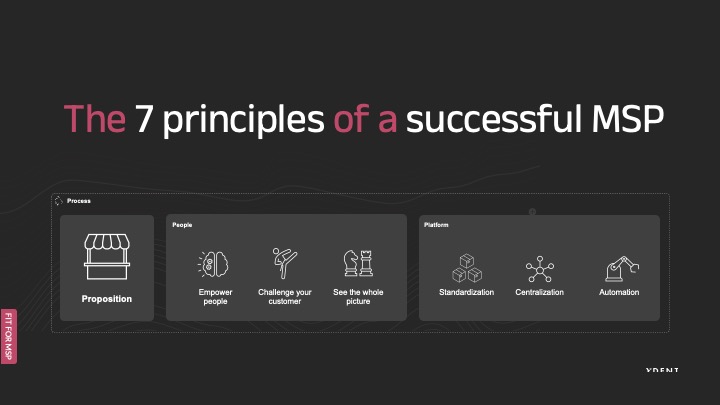Are you, as a Managed Service Provider, constantly putting out fires or are you focused on growth? Only MSPs that adapt and anticipate rapid technological developments achieve success.
Over the past 15 years, including 7 years as a software vendor for Managed Service Providers, we – Jorn Wittendorp (founder of Ydentic) and Micha Bos (partner at Ydentic) – have spoken with over 200 MSPs and industry leaders across Europe. Based on all this knowledge and experience, we have developed the Ydentic MSP Framework. A framework consisting of 7 principles that successful MSPs leverage to adapt to technological developments and grow.
In this blog series, we share these principles with you. We start with an overview of the 7 principles. In subsequent blogs, we will dive into each individual principle. Follow us to discover how you can improve your service offering for your customers. Because success starts with satisfied customers!
Curious about the 7 principles for success as a Managed Service Provider? Then read on.
A Simple and Clear Proposition
Every MSP needs a clear value proposition. If you make your services easy to understand, it’s simpler for your customer to choose. Consider which services offer them added value and present these as standardized packages. Think of it like the plans offered by telecom providers: they also make it clear what you can expect for which price.
Focus your proposition on the benefits of your services for your customer. They don’t care about features, only how your solutions solve their problems.
Empower Your Team with the Right Tools
You need to be able to deliver on your value proposition. Therefore, give your team the right tools. And ensure they have the autonomy and resources to act independently, so they can quickly and efficiently respond to customer needs and inquiries.
What you want is a proactive attitude from your team. This has a dual benefit: it positively impacts your customer satisfaction and your bottom line. We’ll dive deeper into this in our third blog on “Empowering Your Team”.
Challenge Your Customer
A proactive approach also means sometimes saying “no” to a customer. Ultimately, you help them best by critically assessing what they really need, rather than simply fulfilling their wish list. After all, you are the expert and know more than they do in your field. This allows you to offer solutions that not only improve their workflows but also strengthen your mutual relationship.
See the Bigger Picture
If you keep doing what you’ve always done, you’ll keep getting what you’ve always gotten. If you want to grow as an MSP, you need a team that acts according to the company’s vision, not on their own. Make sure everyone is on board and understands the company’s vision and why. For example, it may sometimes be easier for an engineer to come up with their own technical solution. In the long run, standardization is better, because this allows you (and your customer!) to scale.
So, as long as everyone knows what the dot on the horizon is and what you are working towards, it’s easy for them to think: is my way of working helping the company move forward? Only then can your company grow.
Standardization
This benefits the customer. But it also has advantages for your own business operations. Every deviation from standard processes has consequences within your organization. Loss of time, unnecessarily deploying talent and capacity on “dumb jobs”, higher costs, etc. By keeping tight control over these processes, your employees are in the lead and do not work reactively all day.
Centralization
The 6th principle we see in successful MSPs is centralization. This improves the effectiveness and scalability of your service management. By consolidating existing management tools and managing your customers in one place, you create an environment that is easier to manage. As an added benefit, you increase security, since you are not monitoring and patching all sorts of different tools.
Moreover, centralization enables you to respond more efficiently to the needs of your customers. With a central system, you can serve more customers without increasing the complexity of the environment(s). You can also serve those customers better, because your expertise no longer needs to be divided across multiple systems. Win, win, win, win.
Automation
The final principle of the MSP framework that helps many MSPs is automation. By executing recurring IT tasks more efficiently, you give your people the opportunity to focus on more important and strategic activities.
However, think carefully about which processes you automate. Some tasks still require human insight and are not suitable for automation. For the tasks where it is possible, the big advantage of automation is that it reduces human errors. This leads to more reliable results. In our last blog, we give concrete examples of what you can and cannot automate.
With automation, you can handle more work with the same number of people, enabling faster responses to customer inquiries without having to expand your team. However, automation is never the main goal; it is merely a tool to improve your service while maintaining the quality of personal contact and customer service.
Getting Started
In our years of experience with hundreds of MSPs across Europe, we consistently saw that the most successful companies apply these 7 principles. They form the basis of the MSP Framework and have a positive impact on both the efficiency of your business operations and the satisfaction of your customers.
Do you want to learn more about these principles? Then keep an eye on our blogs. Every other week we dive into one principle.
If you want to know more about how Ydentic can support you in implementing these principles, or if you have any questions about our services, don’t hesitate to get in touch. You can reach us by phone or email for a good conversation about managing (complex) Microsoft IT environments.


